Ambrosia Salad Vs Watergate: What's The Difference?
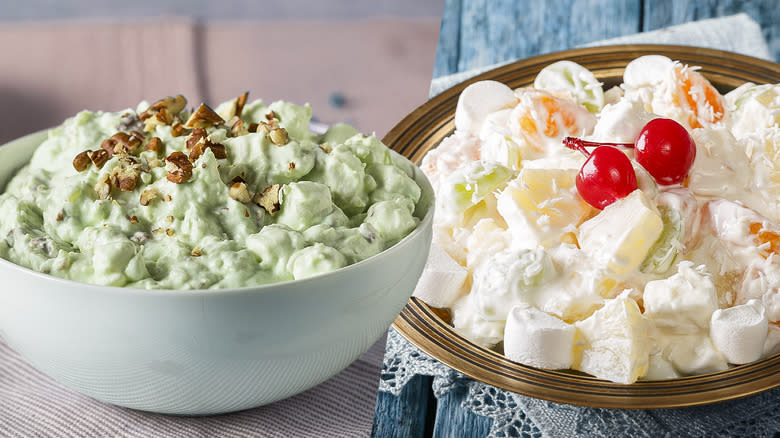
Chances are, if you've ever been to a Midwest or Southern potluck or barbecue, you've seen the infamous brightly colored fruit salad covered in a fluffy dressing. This dish could only be ambrosia salad -- or, perhaps, Watergate salad. These two famous fruit-based dishes could be cousins in terms of looks and flavor. At first glance, you might not even be able to tell the difference between the two salads, but each one has distinct features that set it apart as well as its own unique history.
Ambrosia and Watergate salad have both long been staples in the Midwest and many people grew up enjoying these sweet dishes at parties and family gatherings. These retro sweets can make for excellent side dishes or desserts depending on the occasion. The creamy, sweet flavors of both white, coconut-forward ambrosia salad and green, pistachio-laced Watergate salad are mild and pleasant. Plus, both dishes are easy to make, which adds to their popularity. These fruit salads are major crowd-pleasers, so, next time you need to bring a dish to a gathering, you might consider whipping one up as an old-time callback to classic recipes.
Read more: 13 Simple Tricks To Pick The Best Fresh Fruit Every Time
What Is Watergate Salad?
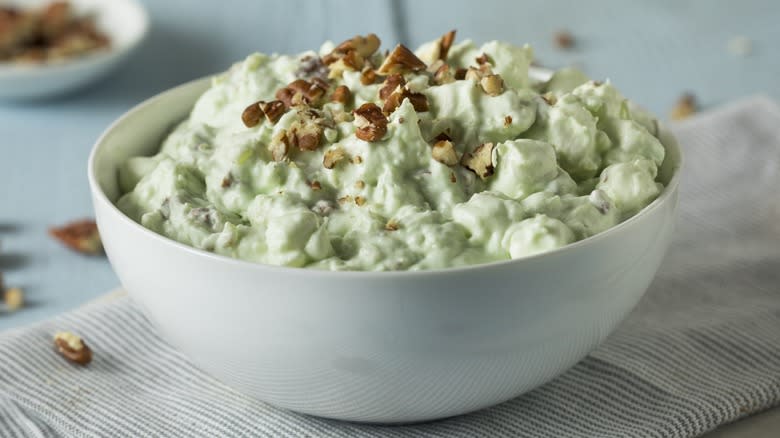
You can identify Watergate salad, also called pistachio delight, by its bright green hue, fluffy texture, and traditional bright red maraschino cherry topping. Watergate salad consists of crushed pineapple, walnuts, pistachio pudding mix, a whipped topping like Cool Whip, and marshmallows. The origin of this salad can cause some confusion, as it was not originally a signature dish of the infamous Watergate Hotel. It's believed that Watergate salad got its name from a cake that uses similar ingredients and has a nearly identical taste.
According to NPR, the Watergate cake got its name due to its thick coating of green whipped frosting that was, much like the Watergate scandal itself, a "cover-up" for its nut-filled interior. Watergate salad reached its height of popularity in the '70s, brought on by the gelatin-based dessert craze and Jell-O food trends of the time. The salad, which is most traditionally served as a dessert, was a playful take on the cake that fit the current food fads. It's sweet and surprisingly refreshing and the unique blend of ingredients provides a great textural array throughout.
What Is Ambrosia Salad?
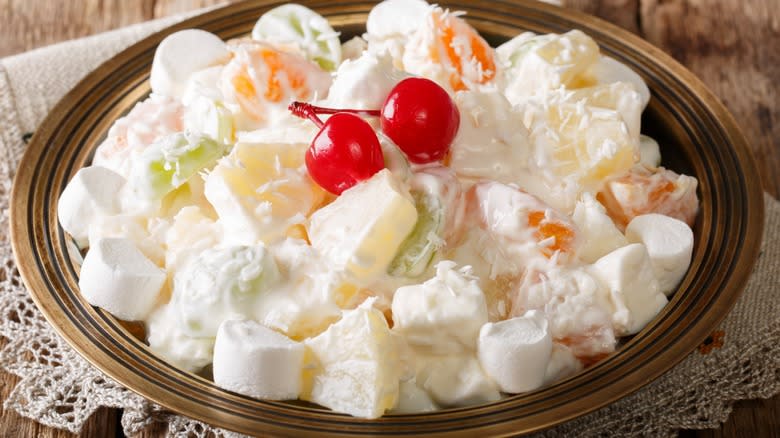
Ambrosia salad is a Southern staple. This tropical, fresh-tasting fruit medley has flavors of coconut, pecans, mandarin oranges, pineapple, marshmallows, and Cool Whip. But what makes ambrosia salad unique is the addition of sour cream, which adds a slightly savory and tart finish to the dish. Ambrosia salad's name actually comes from Greek mythology, where ambrosia was referred to as the food of the gods. Ambrosia salad can feature a myriad of different fruits depending on your family's recipes or your preferences.
This fruity salad is an old-school recipe that has been passed down for generations. Despite having a creamy element, ambrosia salad is quite refreshing and makes for a good palate cleanser when served among heavier Southern dishes. It's believed that ambrosia salad originated from an 1867 cookbook by Maria Massey Barringer titled "Dixie Cookery; Or, How I Managed My Table for 12 Years." The North Carolina-based recipe soon spread throughout the South and became the staple it is today.
Ambrosia Salad Tastes Like Coconut, Watergate Salad Tastes Like Pistachio
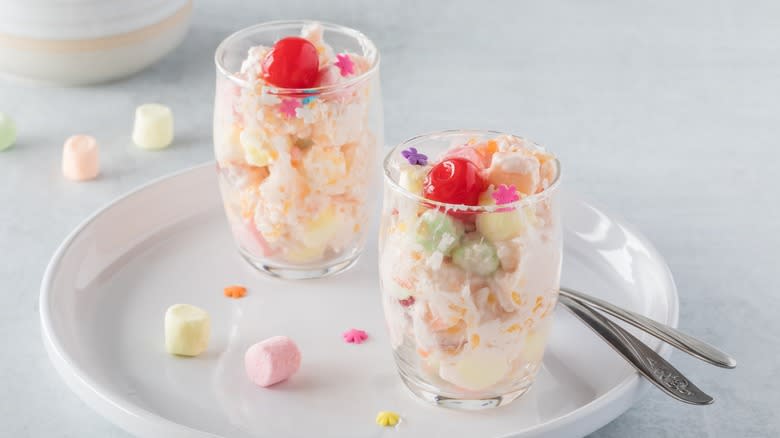
One of the first things that sets ambrosia and Watergate salads apart is the flavor profile of each dish. Watergate salad uses a pistachio instant pudding packet and often calls for additional garnishings of pistachio on top. This gives Watergate salad a nutty, sweet flavor with that hint of earthiness that you get from pistachio flavoring. It brings a subtle warmth to the dish that is further emphasized by the addition of walnuts, which contrast with the creamy component for a uniquely balanced dish.
On the other hand, ambrosia salad features a prominent coconut flavor thanks to the addition of coconut flakes. Some recipes even have you assemble the salad in layers with coconut in between each one. The coconut shavings give ambrosia a sweetness that balances the tart, tangy element from the sour cream. Coconut also gives ambrosia a unique texture throughout from the stringy pieces, making the salad a little more chewy.
Ambrosia Features Multiple Fruits, Watergate Focuses On Just One
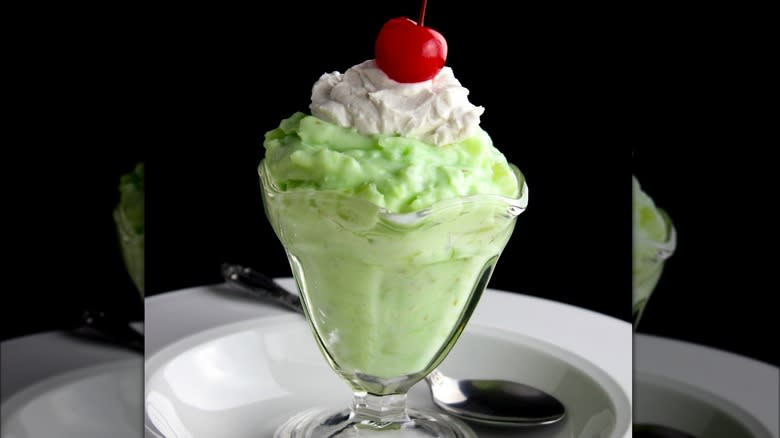
Ambrosia salad does not limit itself to just using pineapple as Watergate salad does, though most recipes do feature this fruit among the medley. Other popular fruits in ambrosia salad include apples, mandarin oranges, and grapes, which give you more variety and creativity when it comes to making the dish your own. Everyone has a combination of fruits that they enjoy using in the salad, and you can try different inclusions to see what you like best. This makes ambrosia feel like more of a true fruit salad than Watergate salad.
Meanwhile, Watergate salad traditionally only calls for crushed pineapple. This gives the dish more of a one-note flavor, but that's not necessarily a bad thing. If you're a pineapple lover you may lean more toward Watergate salad. It gives the dish a pleasantly sweet taste and makes for a smoother texture that matches the softness of the fluffy pudding blend. It also makes the process of prepping Watergate salad a little easier compared to ambrosia, since you're just using a can of pineapple.
Ambrosia Is Mostly White, Watergate Has A Signature Green Hue
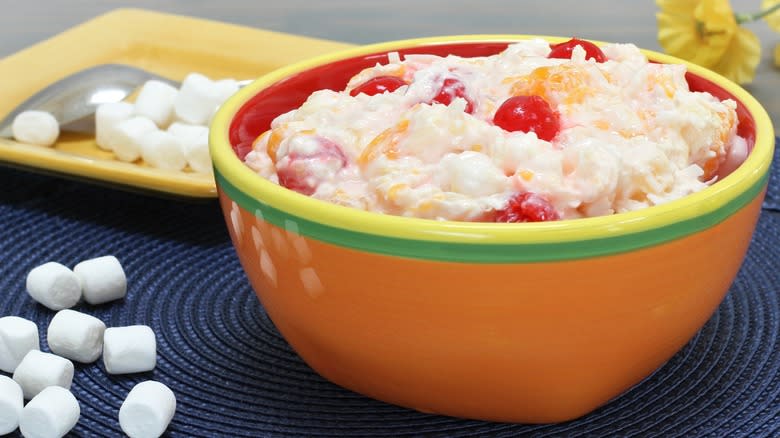
One of the dead giveaways that what you're looking at is a Watergate salad is the signature minty green color that comes courtesy of the pistachio pudding blend. As mentioned previously, Watergate salad soared in popularity during the '70s, a decade that favored a multitude of colorful, bright dishes that were meant to look intriguing and fun. The coloring of Watergate salad adds to the pistachio flavor that's present in the dish and is one of the features that makes it so unique.
Ambrosia, on the other hand, is mostly white with hints of the colors of the fruit peeking through. The Cool Whip and sour cream are responsible for the white hue of ambrosia, but it still remains aesthetically pleasing to the eye. The white color also matches up with the shaved coconut for a complementary look and taste. While the primary color of the dishes is different, they both have accents of red from the inclusion of maraschino cherries.
Read the original article on Tasting Table.

